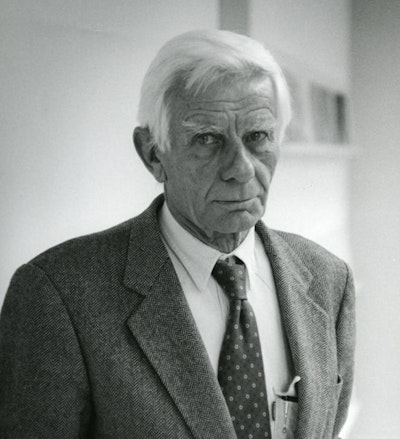
Enrico Castellani
Enrico Castellani, (Castelmassa, 1930 - Viterbo, 2017)
Enrico Castellani nasce a Castelmassa, Rovigo, il 4 agosto 1930. Nel 1952 si trasferisce a Bruxelles, dove frequenta i corsi di pittura e scultura all’Académie des Beaux Arts e nel 1956 si laurea in architettura all’École Nationale Supérieure de la Cambre. Rientra a Milano e inizia a lavorare nello studio dell’architetto Buzzi, con il quale collaborerà sino al 1963. Nel 1959 realizza la sua prima superficie a rilievo. Con Piero Manzoni prende parte alle esperienze del gruppo Zero e, per mostrare il proprio lavoro e far conoscere quello di altri artisti mossi da analoghe tensioni, fonda la rivista “Azimuth” e l’omonima galleria dove, nel 1960, tiene la sua prima personale. In quello stesso anno espone tre superfici a rilievo alla mostra “Monochrome Malerei” allo Städtisches Museum di Leverkusen e, con Manzoni, espone alla Galleria la Tartaruga a Roma; nel 1962, sempre con Manzoni, espone alla Galerie Aujourd’hui a Bruxelles e partecipa alla rassegna “Nul” allo Stedelijk Museum di Amsterdam. Nel 1963, a Milano, espone con una personale nella Galleria dell’Ariete, nel 1964 propone tre tele alla XXXII Biennale di Venezia e partecipa al Guggenheim International Award a New York.
Nel 1965 una sua grande Superficie bianca è presente al Museum of Modern Art di New York nella mostra “The Responsive Eye”, e altre opere rappresentano l’Italia alla Biennale di San Paolo, e a “Trigon 65” al Burggarten/Palmenhaus a Graz. Nel 1966 espone in una sala personale alla Biennale di Venezia per la quale riceve il Premio Gollin, soggiorna per un periodo negli Stati Uniti e realizza le opere che esporrà nella sua prima personale a New York alla Betty Parsons Gallery. Nel 1967 viene invitato a costruire un’opera ambientale per la rassegna “Lo spazio dell’immagine” in Palazzo Trinci a Foligno, in parte distrutta dopo la mostra ne realizzerà una seconda versione nel 1970 nell’ambito di “Vitalità del negativo nell’arte italiana 1960/70” al Palazzo delle Esposizioni a Roma.
Dopo un momento di esilio in Svizzera, nel 1973 rientra in Italia e si trasferisce a Celleno, un piccolo borgo nella provincia di Viterbo. L'importanza della sua opera è riconosciuta e consacrata a livello internazionale. Le occasioni in cui mostra il suo lavoro sono rare e vanno pertanto ricordate le personali e le antologiche da Lia Rumma a Milano nel 1999 (con la quale inaugura lo spazio milanese della galleria), alla Fondazione Prada a Milano nel 2001, a Kettle’s Yard nell’Università di Cambridge e da Greta Meert a Bruxelles nel 2002, alla Galerie Di Meo a Parigi nel 2004, al Museo Pushkin a Mosca nel 2005; sempre da Lia Rumma a Napoli nel 2006 e da Haunch of Venison a New York nel 2009 e nel 2012. Il 13 ottobre 2010 Castellani riceve il Praemium Imperiale per la pittura. L'artista muore a Viterbo l'1 dicembre 2017.
English
Enrico Castellani was born in Castelmassa, Rovigo, on August 4, 1930. He moved to Brussels in 1952 where he studied painting and sculpture at the Académie des Beaux Arts before graduating in architecture at the École Nationale Supérieure de la Cambre in 1956. He returned to Milan, where he worked in the office of the architect Buzzi until 1963. In 1959 Castellani created his first painting in relief. Together with Piero Manzoni, who had ties with artists throughout Europe, he was an active member of the Zero group; he founded the magazine Azimuth and a gallery of the same name. It was there that he held his first solo exhibition, in 1960. In the same year he presented three relief surfaces in the exhibition Monochrome Malerei at the Städtisches Museum Leverkusen, and together with Manzoni, he exhibited at the Galleria la Tartaruga in Rome. In 1962, again with Manzoni, he exhibited at the Galerie Aujourd’hui in Brussels and took part in the exhibition Nul at the Stedelijk Museum in Amsterdam. In 1963 Castellani was given a solo exhibition at the Galleria dell’Ariete in Milan and in 1964 he showed three canvases at the Venice Biennale, as well as taking part in the Guggenheim International Award in New York.
In 1965 he exhibited his large White Surface at the Museum of Modern Art, New York, as part of the international exhibition The Responsive Eye. His works were chosen to represent Italy at the 8th Bienal in São Paulo and at Trigon 65, Burggarten/Palmenhaus in Graz. In 1966 he received the Golin Prize for the works he exhibited in a solo exhibition gallery at the Venice Biennale and spent time in the United States, where he held his first American solo exhibition, at the Betty Parsons Gallery, New York. In 1967 he was commissioned to create an environment for the exhibition Lo spazio dell’immagine in Palazzo Trinci in Foligno; this was partially destroyed after the event and Castellani created a second version in 1970 as part of Vitalità del negativo nell’arte italiano (1960/70) at Palazzo delle Esposizioni, Rome.
After a brief exile in Switzerland, Castellani returned to Italy in 1973 and moved to Celleno, near Viterbo. In recent years the importance of his work has been recognized and validated internationally. The occasions on which he exhibits his work are rare; worthy of mention are his solo and retrospective exhibitions at the Lia Rumma Gallery in Milan in 1999 (inaugurating the gallery’s venue in Milan); Fondazione Prada in Milan in 2001; Kettle’s Yard at Cambridge University; the Greta Meert in Brussels in 2002; Galerie Di Meo in Paris in 2004; the Pushkin Museum of Fine Arts in Moscow in 2005; again at the Lia Rumma in Naples in 2006 and Haunch of Venison in New York in 2009 and 2012. On 13 October 2010 Castellani was awarded with the Praemium Imperiale for painting. The artist died in Viterbo on December 1, 2017.
